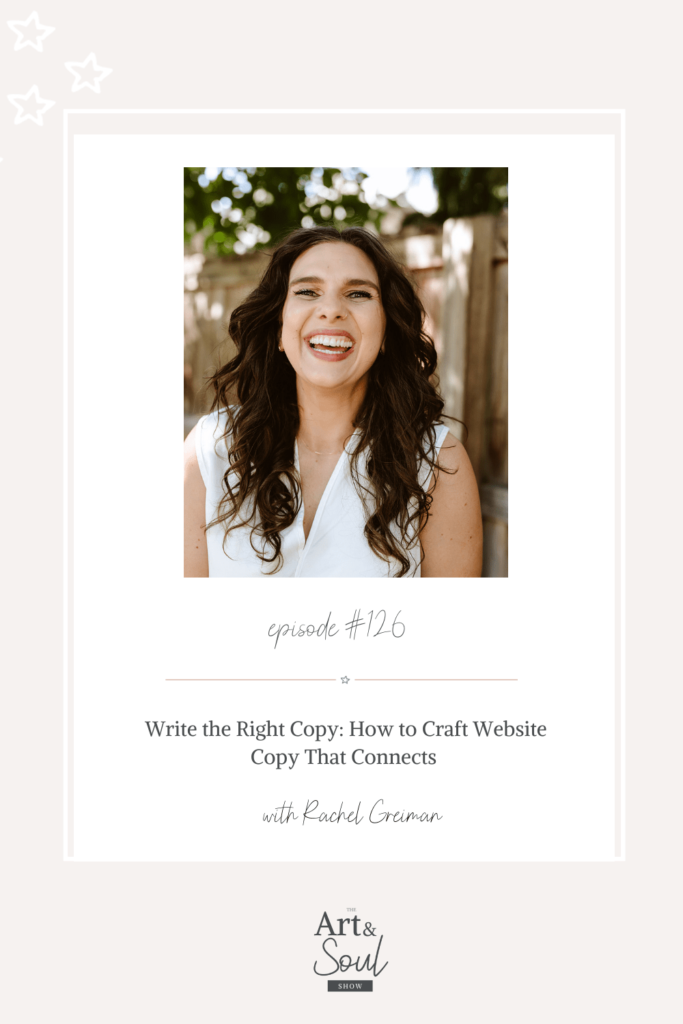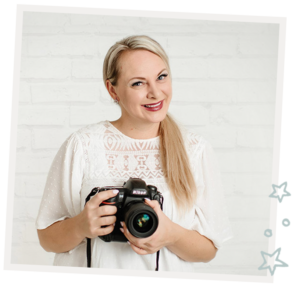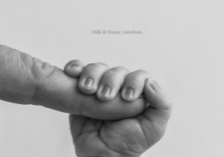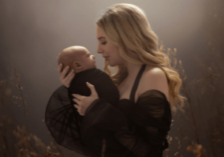Write the Right Copy: How to Craft Website Copy That Connects with Rachel Greiman
It might seem like your images sell themselves, but there’s a lot going on behind the scenes, not the least of which is your website copy. Even strong writers can struggle with copy. But once you understand your audience and your own voice, you’ll be able to connect with your readers and gently guide them to become clients.

In this episode, I chat with copywriter and owner of Green Chair Stories Rachel Greiman all about writing website copy for photographers.
We talk about finding your brand voice and keeping it consistent across your brand. Rachel shares her advice for photographers who aren’t natural writers but still want to show up authentically. Plus, she shares some common cliches and mistakes you should avoid in your website copy.
What’s in this episode:
- How Rachel transitioned from photography to her copywriting business [2:22]
- Common website copy mistakes to avoid [4:12]
- Focusing on the “joy points” in addition to the pain points [5:54]
- How to write creative copy that sets your business apart [8:43]
- What to do if you find out your copy has been plagiarized [10:53]
- How to find your voice and keep it consistent across your brand [12:44]
- How to write about your packages and pricing without sounding salesy [15:43]
- How to start writing if it doesn’t come naturally to you [18:13]
- Why you should always start with research and data when writing copy [23:18]
- Cliches and pitfalls to avoid in your copy [26:35]
- Where to start when you decide to rework your website [29:11]
- Rachel process for done for you vs. work with you services [32:36]
- Rachel’s best advice for someone just starting out [38:30]
If you want to write website copy that connects with (and converts!) your dream clients, tune in to this episode.
SUBSCRIBE: iTunes | Spotify | Stitcher
Resources Mentioned
Building a StoryBrand by Donald Miller
The Artist’s Way by Julia Cameron
Meet Rachel Greiman
Rachel Greiman is a copywriter who owns Green Chair Stories, a copywriting collective based in Denver, Colorado that writes websites for photographers. She believes cookies are a perfectly acceptable breakfast food, as long as you eat some salad later. She lives with her giant dog (an 80-pound bernedoodle named Bernadette), her giant husband (a 6’6″ man named Travis), and her currently little (but probably soon-to-be giant) babies in a bungalow in the city.
Connect with Rachel
Did you love hearing about how Rachel helps photographers find their voices and connect with their audiences? Check out another episode from Mark Rossetto
Transcript:
[00:00:00] Rachel Greiman: All copywriting – if you struggle with articulating yourself, be clear, not clever. That’s a Donald Miller staple in his Story Brand framework. Rather than trying to be cutesy and name your packages a certain way and present it in a fun way or be salesy about it, just be clear. Like I have a lot of photographers who have one package and it’s customizable and they say, I got one package. This is where it starts. We can add things, we can take it away, we can add a second shooter, we can add hours, we can put an album on if that’s what you want. I just think that if you sound like a person on your pricing page, people are going to want to talk to you and think like, okay, this is a human. This isn’t someone trying to sell me something. So I always say honesty and clarity trump everything when it comes to your pricing. If you’re trying to hide something, people are going to feel it.
[00:00:53] Lisa DiGeso: Welcome to the Art and Soul Show, where we dove into heart opening chats on photography, business, life and that messy in-between. I’m your host, Lisa DiGeso, a mom, a photographer and entrepreneur. And I’ll be sharing honest conversations and advice for photographers with insight on mindset, entrepreneurship and creativity. The goal of this podcast is for you to be able to gain insights and strategies that will get you real results. Because, let’s face it, having a photography business can be lonely but it doesn’t have to be. This is the place you can go when you need a boost of encouragement, a kick in the pants and inspiration to pick up your camera. This is the Art and Soul Show. Hello, my beautiful friends. Welcome back to the show. Today I’m chatting with Rachel Greiman, and she’s a copywriter who owns Green Chair Stories, a copywriting collective based in Denver, Colorado, that writes websites for photographers. She believes cookies are a perfectly acceptable breakfast food as long as you eat some salad later. She lives with her giant dog, an 80 pound bernadoodle named Bernadette, her giant husband, a six foot six man named Travis, and her currently little but probably soon to be giant babies in a bungalow in the city. She’s a copywriting expert and I am so excited to dove into our convo today. So without further ado, here is Rachel.
[00:02:16] Rachel Greiman: Hi, Lisa. Thank you so much for having me.
[00:02:18] Lisa DiGeso: Welcome. Well, tell us who you are and what you’re passionate about.
[00:02:22] Rachel Greiman: I mean, that is a long answer, but I will try to keep it brief. So, like you said, my name is Rachel and I run. Read your stories. We have been around since 2014. We started as a family photography business because I have always been a photographer and a copywriter. I worked in the nonprofit world before I started going to your stories, and then I was in all the Facebook groups with other photographers trying to figure out how to run my business. And everybody is asking questions about how to write their website. And I was like, Oh, that’s a no brainer. I can help there. It was like my way to contribute back to the group when I was asking all the business questions, and then it quickly became apparent that that was a smarter career path. So I still photograph families, just like it’s a subset of the business. And now we write more than 50 websites a year for photographers and we have a team of four writers and my assistant, and I’m just really passionate as far as my business goes about helping people figure out why they’re different. I find that photographers have a really hard time putting into words like they can feel it in their creative, artistic soul. What makes them different from the photographer down the street? But they struggle putting that into words and selling themselves. You know, I think photographers have a really hard time feeling salesy. And I think if you’re really legitimately just talking about who you are, it doesn’t have to feel salesy. So I’m passionate about helping photographers find what that is.
[00:03:46] Lisa DiGeso: I love that. I think you hit the nail on the head because I think as artists and creatives, art may naturally come to us or just like that love of photography, but we stumble on our words, whether it be even like showing up on social media, how we show up on our websites. Because I know sometimes, like, I just sit down and I’m like, do do do blank pages. Don’t know what to say.
[00:04:06] Rachel Greiman: Right. Yeah, I’m a writer and I have a hard time with the blank page. It’s tough, especially when that’s not why you got into business.
[00:04:12] Lisa DiGeso: Exactly. Now, what would you say some of the biggest website copy mistakes are that you see?
[00:04:18] Rachel Greiman: I mean, that could be an hour long episode, but right away when you said that. I think a big one that I’m seeing right now is that people buy a template from a design studio or a creative someone and whatever platform it is, Squarespace, show it. WordPress, you know, all the different platforms. I think those templates come with pre-written sections and put this year. And while that’s very helpful, I think that’s a helpful prompt for people who really, really struggle with writing. I find that it boxes photographers in and they don’t really think about the journey that their client needs to go on and the message that they need to read and when they need to read it and they just fill in the prompts rather than strategically looking at, Hey, what’s the first thing someone should read when they come to my site? It probably shouldn’t be about me. And a lot of those templates will have that first section on your home page be about you. Yeah. And so I think the biggest mistake I see is photographers just following those prompts rather than thinking about something strategically and about, Hey, how can I jump into the conversation my reader might be having in their head, rather than just blindly following what this template is telling me to say?
[00:05:28] Lisa DiGeso: I love that. I think that’s really like I’ve been. I have had my website since, oh gosh, maybe 2010. And I’ve really seen a shift on what we’re putting on our websites and how we are serving our clients, whereas before, it used to be like, This is me, this is my work, book me now here’s my pricing, it’s all about me. And it’s really shifted to like, here’s your client or prospective client all about them. What’s their problem? What’s their problem? They’re there to solve, right?
[00:05:54] Rachel Greiman: Absolutely. Yep. And people, if you listen to any podcast or read any book about copywriting, you’ll hear people talk about pain points. You know, what’s the pain point that they’re struggling with? And I think with your audience, mostly portrait photographers, you know, a lot of family, maternity, newborn, that’s a little bit easier because that phase is so hard. You know, you’re pregnant or you just had a newborn. It’s really easy to identify what the point of your client might be. When I think about wedding photographers and family photographers too, I would rather see copy focus on the joy point. Like what is the reason that they want their family photographed is because of the happiness that they’re feeling, you know, not necessarily because it’s painful. Now, I do think it’s important to mention what’s difficult about hiring a photographer or about actually getting the session on the calendar or about having a session. I think photographers should go into the pain of it all. But right on that home page, I see so many people who have listened to a podcast or read a book and they’re like, Oh, I gotta go right to the pain. And it’s like, I don’t know that you want to talk about pain right away on your website or about why it’s difficult. There’s other parts that are happy and joyful and resonant with clients that are good.
[00:07:05] Lisa DiGeso: I love that. That’s an interesting take. I’ve never thought of that because I mean, that’s what you do here in marketing is like, Yeah, you got to hit the pain points, you know, prompts people to buy. But you’re so right, they’re actually searching a lot of the time for a joyful reason. So why are we taking away the joy and telling them, okay, I get this hurts? And you’re like, but it doesn’t hurt. And I’m just looking to document the joy. Right.
[00:07:26] Rachel Greiman: Right. I just think like, the years are fleeting and they’re going by really fast and I want to remember them. Why are you telling me about, like, right away how hard it is? Yeah, and I’m not saying it shouldn’t.
[00:07:36] Lisa DiGeso: Be like.
[00:07:37] Rachel Greiman: Yeah, I’m like that’s not, it’s not that it shouldn’t be touched on, but I think that’s something that’s really good for content vlogging, Instagram posts, stories, reels like pain points are a lot easier if it’s quippy and it’s not. Like the thesis of your entire website is focused on how hard it is to hire a photographer. You don’t really sound like a good time to be around if that’s everything that you’re talking about.
[00:07:59] Lisa DiGeso: Love that. That’s a great perspective. One thing I really notice, because I do a lot of work where I am researching people in the industry doing amazing things, whether to bring them on the podcast or come teach with us for our online retreats. But one thing I really notice is a lot of the times people are missing who they are, where they’re located, what their name is, and like how I can find them elsewhere. Yeah. And I find that shocking, but it’s so missed.
[00:08:22] Rachel Greiman: Yeah. At the very least, I always tell people, just put all of that in the footer. Yeah. So on every page people can see your location, your name and your social links and an email address. An email address is a big one. I think people are afraid to put their email address on because they don’t want people like just cold reaching out to them. But I’m like, why not make it as easy as possible if somebody doesn’t have all the contact forms? Let them.
[00:08:43] Lisa DiGeso: I love that. So what advice do you have on creative copy that stands out instead of blending in?
[00:08:49] Rachel Greiman: Yeah. I mean, I think Joy is one of them, you know, talking about and I said the word thesis and that’s a little too heady, but having a big idea when you start your website, that opens a loop. So when you examine all your past clients that you really love working with, what is the main reason they came to you? What is the main reason they said yes to you? That’s your big idea that you lead with on your homepage and that should carry through and you should close that loop on your contact page. So I think standing out is having a big idea in the first place. Again, going back to the mistake of people just filling out the template, those templates often don’t give you the chance to introduce an idea. And so the idea might be that time is leading. The idea might be that you’ve never done this before and you don’t know what you’re doing and you need a guide to help kind of shepherd you through. If you’re an in-person sales photographer, it might be printing your images and having proof, like tangible proof. So you need to come up with your big idea and that’s going to help you stand out. And the way to do that is shocking. Not by reading other photographers’ websites. I think a lot of people sit down to write their site and they’re like, Well, what is this person doing? You know, what is that person doing? And I think that can be really detrimental because then you’re not going to be able to get their voice out of your head. I would much rather people go back through the clients that day. Real people, not an avatar, real people that they loved working with and think about how they felt photographing them, what the client loved about the session with them and how that’s been replicated in other sessions. So that’s where your big idea comes from. The proof is in your real lived experiences, not what other people are doing.
[00:10:35] Lisa DiGeso: Yeah, I love that. And I think I think that there is one topic that, you know, we like to avoid, but it’s actually copy plagiarism. And I know it really happens a lot in the industry. It is like we hate photographers. We hate when people take our work and use them to sell.
[00:10:50] Rachel Greiman: Totally.
[00:10:51] Lisa DiGeso: Their stuff. So why would words be any different?
[00:10:53] Rachel Greiman: Right. They’re not. And I always tell my clients and remind them, Hey, run your site through CopyScape.com. That’s a free resource that you can use. I think you get like 3 to 5 pages a day that you can run through for free and it’ll show you if anybody’s copied you and it’ll show you the exact website. And so I’ve reached out to those client. Like if somebody has copyrighted words that I’ve written for a client, I’ve reached out to them before and I just send them a video and I’m like, Hey, this is the same and this is the same. It’s got to be taken down by the end of the day and it’s really nice. Yeah. Like I don’t do it in a mean way at all, but it’s more like, I’m not going to ignore this. They paid a lot of money for these words, so.
[00:11:32] Lisa DiGeso: Now what course of action would someone have if they noticed that their words were plagiarized?
[00:11:38] Rachel Greiman: I mean, everybody should have a lawyer. It would be a cease and desist from your lawyer. I say, yeah, but usually someone’s seeing my face in a Loom video. Walking them through the similarities between their site and another site is enough to like. I’ve never had to have anybody go that route.
[00:11:51] Lisa DiGeso: Interesting. I just find it so fascinating because I know, like, because we get up in arms as photographers when it’s happened to me. Sometimes we like it when I see my work being used to promote something that I’m completely not affiliated with. So yeah, I always find it so fascinating. Copy that. It seems to be a swipeable thing that people think it’s okay with and it’s actually not right.
[00:12:12] Rachel Greiman: And I think that’s hard because copywriters would talk about swiping templates because you can see the template of someone, say, in the structure, and that’s okay to steal quote unquote, as long as you’re in putting your own words. But I always say if you’re going to steal from someone, steal from outside your industry, and steal is like an aggressive term. I mean, look at their template, see how they set up a page and then make it your words, your people, and never take a word from someone else’s.
[00:12:40] Lisa DiGeso: Love it, so don’t borrow your personality.
[00:12:42] Rachel Greiman: Yeah, exactly. That’s a great way of saying it.
[00:12:44] Lisa DiGeso: So how do you find your own copy voice? And it sure, it stays consistent throughout your website and your social media and your emails practicing.
[00:12:53] Rachel Greiman: I think it’s really important that you practice, especially in the beginning. I mean, we won’t work with a client if they haven’t photographed a certain number of sessions or if they haven’t been in business for a certain amount of time. Not because we’re too good for them at all, but because I think it’s a waste of their money if you don’t know who you want to target and who you’re talking to, I’m not going to let you spend thousands of dollars on something. And so I think those early days of business, when you’re just kind of figuring it out, DIY thing is the best thing that you can do because it gives you practice and it gives you clarity around who you are. So finding your copy voice is as much about knowing yourself as it is about knowing your clients. So it’s kind of like you got to kiss a lot of frogs until you figure out who you want to be working with. And so I think all of us did this. I did. In the beginning, I would photograph anything. Yeah, you know, why not more money, more people. But that quickly comes back to bite you in the butt because people don’t know who you’re for then. And the more specific you can be about who you’re for, the more specific you can be about your brand voice. And so when I think about my clients and my past clients who I love, I can be like, Sheree has the sense of humor. She would make this joke and we related on this topic. If I think about writing my entire website to this person that I have real lived experience with, that’s my voice. And a really easy way to do it for people that struggle with that blank page and the blinking cursor is talking, I just open up my voice memos on my phone. Sometimes if I’m struggling with something and I say, okay, this is what I’m trying to say in this section. This is who I’m talking to, and this is the voice that I want to have. And then I’ll just say it or I’ll record a conversation with my husband in the same way. This is what I’m trying to say. This is how I want to say it. And then after 3 minutes of verbal processing, I have found a golden nugget that I can work with so the blinking cursor can be so intimidating. But just talking, at least for me, I’m like the verbal list of processors. Sometimes talking is so much easier. And there’s talk to text in Google Docs too.
[00:14:56] Lisa DiGeso: Yes. Yes.
[00:14:56] Rachel Greiman: So you can use that feature in Google Docs if you just want it to record what you’re saying.
[00:15:00] Lisa DiGeso: I love that so much because, you know, it’s funny because like I buy courses and I’m like a course junkie. Yeah, right. I love them so much. But when it comes to doing the work in the workbook, I’m like, Yeah, I don’t want to write it down. But as soon as you were to be like, Hey, Lisa, here’s the questions, I’d be like, Here’s my answers, and it’s fine. And so I’ve really discovered recently that I’m a verbal processor, and in order for me to get things done, that’s what it takes for me to to do it totally.
[00:15:29] Rachel Greiman: And I found that because I’ll be on calls with my clients and the best pieces of writing that I can jump from are as I’m talking to them and thinking out loud, I’m like, I might be a writer, but my best stuff comes from talking.
[00:15:41] Lisa DiGeso: Yeah, I love it. I love it. So I think a major tough point is the wording in the language around package packages and pricing. So it’s clear for clients and that they know what to expect. Act. So do you have any advice on that, where it’s like, okay, do I keep it? You know? Do I send it? Do I put it on the website? Do I send it out? Or like, how do we get around this?
[00:16:00] Rachel Greiman: I mean, there’s so many different sales tactics, and I always hesitate to speak to them because I’m not a sales expert. I mean, a copywriter should be a sales expert to some extent, but I’m not going to. There’s so much that goes into that from your marketing funnel, like how you’re getting people to your site, what your sales process is like after they slide into your inbox. So there’s not really a generalized rule of thumb that should say, well, you have to have starting prices or you have to have all of that. It really depends on your market, your competition and your price range. So yeah, there’s not like a blanket statement I can give, but for me, I have always seen that my best inquiries come from putting starting prices on because you’re at least giving people an idea and you’re going to kind of throw away price shoppers at that point because they can see how much you cost. But all copywriting, if you struggle with articulating yourself, be clear, not clever. That’s a Donald Miller staple in his Story Brand framework. Rather than trying to be cutesy and name your packages a certain way and present it in a fun way or be salesy about it, just be clear. Like I have a lot of photographers who have one package and it’s customizable and they say, I got one package. This is where it starts. We can add things, we can take it away, we can add a second shooter, we can add hours, we can put an album on if that’s what you want. I just think that if you sound like a person on your pricing page, people are going to want to talk to you and think like, okay, this is a human. This isn’t someone trying to sell me something. So I always say honesty and clarity trump everything when it comes to your pricing. Because if people feel like you’re hiding something, if you’re trying to hide something, people are going to feel it.
[00:17:43] Lisa DiGeso: I love that. It kind of reminds me of when you go to a restaurant and they have this super wordy menu of like all these ginormous words and you’re like, I don’t even know. Like, I’m such a foodie. Sometimes I’m just like, this doesn’t sound good. And I don’t know, like, I don’t even know. Like, Yeah.
[00:18:01] Rachel Greiman: You’re overselling this. That’s how I feel sometimes on those menus. Just give me the bare minimum.
[00:18:05] Lisa DiGeso: Yeah, it was like this one for gazpacho or something, which I’m like, so it’s cold soup, right? Right. Okay, we’re good.
[00:18:11] Rachel Greiman: And the main ingredient is what?
[00:18:13] Lisa DiGeso: Yeah. Yeah. Oh, dear. So many of the talk of her struggle with writing copy, whether it be for their website emails or even social media posts. So what advice do you have to start working that writing muscle if it really doesn’t come naturally to you?
[00:18:29] Rachel Greiman: Yeah, my big tip is talking. Either talking to somebody that you love and trust or to yourself. Another way to kind of exercise that muscle is through using props. Like you can even search the hashtag social media prompts and you’re going to get all these challenges that come up. I think having a framework, again, people think about niching down and it feels like a box, like how can there be more money to be made within a smaller reach? But think about writing the same way. It’s easier to write if you put a framework around it, and it doesn’t have to be photography either. Like Laura Tremaine, she’s somebody that I follow on Instagram and she does like one a day in May and she has a different prompt every day of the month for May, and it’s just a social media challenge where people are posting. And I think that just exercising that writing muscle with other people’s words and like you said, the blank page is the hardest place to start. So if you can put a sentence like today, I’m going to write about something that meant a lot to me as a child. Who knows what’s going to come from that. It might be something irrelevant that you’re never going to post on social media, but it was still practice. Julia Cameron’s book, The Artist’s Way, I think, is brilliant and wonderful. She talks about morning pages and it’s just like three pages of whatever she wants to write to get out of her head in the morning. And she said her eyes never see the light of day. It’s not productive. It’s not for anything. It’s just the practice of journaling and getting your thoughts out. And you will be shocked at how much more comfortable you get if you allow yourself to suck at it for a second.
[00:20:05] Lisa DiGeso: There’s such a worry of sucking. I was like, You get so in her head that like, if it’s not perfect, I’m not going to do it and I’m going to try. I’m actually speaking for myself. Yeah, same.
[00:20:14] Rachel Greiman: Same. And I think people are afraid to throw it away. It’s like, well, I just worked on this for an hour and it’s like, okay. And yeah, like, how many times have you edited a photo to death because you wanted it to work and you knew it wasn’t a good wanted to deliver to a client? Yeah, it is the same exact thing. Not all words are worth sharing and not all words need to see the light of day. I can’t tell you how many things I have written that we’ll never see anything. We actually have a section in every copy document that we give to clients called The Graveyard, and it’s at the very bottom. And it’s like, if there’s something you love and you know, it just doesn’t work, don’t delete it. Just cut it and paste it in the graveyard because. We can always come back to it. We can always rework it, but it doesn’t feel as horrible to just paste it somewhere where it’s not going to be used.
[00:20:59] Lisa DiGeso: Yeah, I love that. It’s a great idea because it’s something I really do struggle with is like and also with like I loved, I love the prompts, I love coming up the prompts cause I love all of asking questions totally. But then when it comes to me answering them, I’m like, Why does anyone even care what is right here, what I have to say? Right? And so I kind of just overthink it. And then I don’t say anything.
[00:21:18] Rachel Greiman: But if you think about it all, at least for me, all my favorite people to follow on social media are open about something that other people aren’t. And it’s not like they live like I don’t like following people’s really extravagant lives. It actually stresses me out and makes me feel kind of crappy about my own. So I follow very normal people and see them answer everyday questions. Those are my favorite kinds of posts or stories to engage with because I’m like, Oh wow, I never thought about it that way. So I am constantly training that out of myself. It’s not that I have something unique to say, it’s just that I’m a different person than someone else.
[00:21:54] Lisa DiGeso: Totally.
[00:21:55] Rachel Greiman: And so when you think about yourself in comparison to other photographers, if you just show up as who you are, that’s different enough. You don’t have to try to do what other people are doing and walk someone else’s path. You just need to show up honestly about who you are. That’s it. That’s all there is to it.
[00:22:12] Lisa DiGeso: So what advice would you give to someone who really struggles with that, expressing themselves and maybe just has that opinion of themself that I’m just not a good writer.
[00:22:20] Rachel Greiman: I would challenge them to think about it, not as writing like, this isn’t a high school English paper, you know, this is not that at all. Copy and writing are not the same thing. Copy is a hack. Copy is a formula. It is figuring out who you are, what your client wants, and how you deliver that in a unique way. It is the Venn diagram of those two things, and if you can find the middle, your clients have already done the writing for you in what they say to you, in their questions that they ask, in their inquiries, in their testimonials, that they leave you on your sales calls. What made them say, Yes, that’s your copy. You’re not writing, you’re assembling, you’re taking all the research you’ve done about the people you love to work with, what they’ve said about you and what made them say yes. And then just assembling it on a website, when I get stuck writing a website, that is what I remind myself of. And I open up all of my research about the client and I go back to the client’s words. What do people say about them? That’s what I need to remind people.
[00:23:18] Lisa DiGeso: I love that. Now, what advice would you have for someone who maybe doesn’t have all that gathered research and data yet, and how should they start organizing that so they can grab from that?
[00:23:28] Rachel Greiman: That is a great question. I would guess, like if you don’t have the research and you don’t have the actual data to pull from, you have to give it your best guess. And that is when like, let’s say you don’t have a ton of clients or you’ve never worked with somebody that you’re like, that is them. Then I have people come up with the person that they know in their real life that they would love to photograph. And you make a list of why they love to photograph them. What about that person is appealing to them and why would that person hire them? And again, that’s a guess they don’t know. But that at least gives them the outline in a framework of who they’re writing to. Because who you’re writing to is the most important piece that is missing when you start because you’re not sure yet. You haven’t niche down, you haven’t had the ideal client yet. So it’s an educated guess. And then your copy is a working, living, breathing thing as you learn and as you figure it out. So once you do start to have more of those ideal clients, you kind of tweak things and change things because in the beginning, your website probably isn’t going to be what sells you. It’s going to be a referral from a friend. It’s going to be somebody that you know in real life that’s willing to take a chance on you. Your website is just one giant experiment in the beginning, so don’t be afraid to really play with it.
[00:24:46] Lisa DiGeso: I love that and I love that. You said it’s not sad. Set it and forget it. It’s like it’s a working, you know, project because honestly, because well, it’s funny, I currently do not have a website right now. Mine got hacked in January, like you said.
[00:24:58] Rachel Greiman: That’s awful.
[00:24:59] Lisa DiGeso: Yeah. But, you know, it’s actually an amazing opportunity because I’m actually taking a sabbatical in that business anyway, so I’m restructuring well figuring things out. And like I said, because I actually have not updated my copy on that website since probably 2010. So things have changed a lot. Blessing in disguise, right? So I’m taking this as an opportunity and I just find it so fascinating because I, I really just left it. I thought, okay, it’s one and done and it’s not. So I really love that, you know, I sort of like restarting my business experiment project. Yeah it is really fun on like expressing who I am and what I want to put out there too.
[00:25:34] Rachel Greiman: Absolutely. And to your point before of how websites have been changing so much, that’s a great example. It was static. The whole website experience was static. The homepage didn’t scroll. It was just a gallery of images and a navigation to all the other pages. There wasn’t. Why would you put words on the home page? You’re just here to see my work, right? And in 2010, I always thought about those big gallery sites, and that’s it. That was the whole thing. And maybe in about page and a contact page. And that static element has changed so much. And that, I think is so important for photographers to realize is basically like when you think about how we use our phones and you scroll all day long, all you do is scroll. So your website needs to mimic, needs to be scroll healing. Yeah, yeah. And it needs to be something that feels relevant and that feels up to date because people are bombarded with new and fresh information every day. So if your site looks old, your brand feels old.
[00:26:34] Lisa DiGeso: Yeah, love that. So what clichés or pitfalls should photographers really avoid when it comes to their copy? Maybe just cliches? Yeah.
[00:26:43] Rachel Greiman: Well, I see a lot of the same things and I’ve sent a couple of emails about it, but like, I’m your third wheel on your wedding day, you know, that’s a big one for maternity. I think it’s like just those cliché statements about time. Like, if you can have the idea that time is fleeting, but that probably shouldn’t be your headline because everybody says that. Or I would try to come up with something not controversial, but some like I just wrote a photography site for a family photographer and her clients are like type A business women who were full time in their careers and had kids. So one of the headlines was all about like, you don’t have time for this, you know? And that would not work with somebody who’s a stay at home mom yet and does have the time to sit and scroll if she wants.
[00:27:32] Lisa DiGeso: Yeah.
[00:27:33] Rachel Greiman: And I do not think stay at home moms’ jobs are easier. I have done a lot of stay at home momming in the past two years and it is not easy. Let me tell you what. Work is way easier, but they have access to their phones a little bit more. So you need to figure out who that client is and then think about their core struggle with it and their excitement. Like for a working mom, they’re going to want photos of them with their kids. They’re going to have less time with their kids overall. Yeah. And so talking about time in that regard is going to be different than a stay at home mom who’s like, maybe I want to bring like maybe I want some time in this session for just me and my husband. Like, that’s going to be two different perspectives. Yeah, I think there’s just so many cliches. And again, like not comparing yourself like if you read a ton of other photography sites before you sit down to write your own, you’re going to have all of their words in your head. So looking at poetry, I really, really love to watch cheesy rom coms with weddings in it before I write a wedding site.
[00:28:32] Lisa DiGeso: Rom coms are my favorite.
[00:28:33] Rachel Greiman: I love rom coms so much. Like.
[00:28:36] Lisa DiGeso: Like these movies are like, they’re so cheesy. And even my husband, like, bless him. He will sit down and he will gauge them.
[00:28:43] Rachel Greiman: You sucked in? Yeah, he is sucked in. Not blessed. He loves it. Don’t usually like but any rom com like there’s usually a big idea in the struggle of the relationship of the two characters and that can almost always spur something for me when I’m writing a site. So just looking for inspiration outside of your industry, I think it’s so important to avoid the cliches.
[00:29:06] Lisa DiGeso: I love that I’m going to call watching Hallmark movies my homework now.
[00:29:08] Rachel Greiman: Absolutely it is.
[00:29:11] Lisa DiGeso: So after my website hack happened in January, I’m currently in the process of rewriting and creating my 2022 version of my website, since that old version is completely gone. But it does really feel daunting. So what advice do you have on breaking it down so it feels manageable when starting completely from scratch?
[00:29:28] Rachel Greiman: I think it depends on where you’re at in your business, where you’re at in your business. I would hire out as much as possible. I would hire a website designer and brand strategist. Usually those come together and I would try to hire the same person if I was a photographer and bring in a copywriter as early as possible. So everybody gets on the same page. You have a Web team, and that way, while you’re working on the brand strategy and the look and feel of the brand before you get before you even touch website design, then the copywriter can come in alongside that brand strategist and use their processes to work together to come up with a singular message that your copy and your brand communicates because you want those people involved together and working together because that’s going to give you the most cohesive messaging and you want the copywriter to write the copy before they start the website design. That I think is always clutch and not everybody knows that it’s totally possible to write the copy after the design is finished. It’s not it’s not a huge deal, but when possible, it’s so much easier on both parties if the copy comes first because then the web designer has something to input and they know what they need to work around. Whereas you don’t want the constraint of a specific box that the designer made. Like preventing the copywriter from having freedom to get the message across. Now, people do read long copies. They don’t read boring copies. And if your copywriter does give you a long copy, we tend to write really long websites. That’s just our jam that you want a designer to have that ahead of time because then it doesn’t change the structure too much and the copy informs the design because you need to know how many sections to put on the home page. Like a lot of designers will only have like three or four sections and it’s like, No, no, I need seven. And it is not always, but sometimes. So I just, I think it can be daunting to start from scratch, but it also is a gift because you’re not piecemealing it together then, and you can create a whole team around it.
[00:31:31] Lisa DiGeso: I love that because you know, it’s funny because I, I did the thing I signed up for show it and I punch that, that little thing and, and start plucking my, my pictures in and I’m going, I already hate this and I’ve got these boxes that I’ve got to fill in and I don’t know what to write. And now I’m not going to do it for two months because I’m overwhelmed and I’ve got way too many other things to do. So I love that you’re talking about creating a team that is kind of helping you along because it is. It’s overwhelming.
[00:31:56] Rachel Greiman: It is. And something for you is Show It has. There’s so many great people who do Show It customization. So you’re not paying for a full web rebrand. You’ve bought the template and then you can pay someone to customize it. So either you write your own copy in a Google Docs separate and you’re like, I’m not even looking at the template. I’m just going to write what needs to be said on each page. And then you can give them your photos and you can give them your copy and they’ll customize it for you. So you’re not sitting there trying to get every centimeter right in the template.
[00:32:30] Lisa DiGeso: I love that. Well, I think that’s the direction I’ll be going and for sure. Yeah.
[00:32:33] Rachel Greiman: Well, love, you know, I have so many people to recommend to.
[00:32:36] Lisa DiGeso: I will. So I also see that you have I work with you / done for your service. Can you share a little bit about your process with that?
[00:32:42] Rachel Greiman: Yeah. Yeah. So we have a DIY guide for people that are earlier in their business or want to do it themselves. Takes a lot of elbow grease, but it’s just a 60 page document of our entire process that we take people through and it lets you do it yourself. And then we have a glow up audit service for people who are almost there with their copy, but they just need somebody to take it and make it convert. Usually these clients are good writers, but they don’t know enough about copy to make things convert, and it’s usually a little too long and needs to be edited and headlines need to be better. So that’s like done with your service. And then our done for You service is where you write your whole website for you. It’s five pages , it’s always home about and contact and it’s usually like an experience page and a pricing page or service is an investment, you know, like some combination of those five. And that process is really specific because we have a whole team of writers and I want everybody to be on the same schedule so you can hire me. I’m usually booked out like three months further than my writers are and I’m quite a bit more expensive. But my writers are really, really talented and it’s such a steal to hire them. I always say that because I’m still editing it like you’re still getting my eyes. They’re just the ones walking through the process with you. So when people book that service, we book calls with them on a Monday. And going into that call, we have interviewed 2 to 3 of their past clients. So we have a ton of research there. We’ve read all their Instagram posts from at least the past year, probably more like the past five years. We’ve read every testimonial ever left for them, and we’re coming in with very informed questions. And then we have like an hour long call with them to just get clarity about them and their brand. And then we deliver their first draft a week from that day, and then they have five days to edit with whoever their writer is. So two writers are always on either end of the process from our team, and it’s so it’s 11 days until the whole website is done for you, which is really nice because a lot of photographers are like, I need a copy yesterday. I’m like, Great, we can get it done in 15 days from now.
[00:34:46] Lisa DiGeso: And I have to say, like we’ve, I have worked with other copywriters in the past and it has taken months and months and months. Yeah, I love that. It is so quick. I think that is fantastic.
[00:34:56] Rachel Greiman: Totally. And so once my competition, I’m always shouting out my competition because there’s room for all of us. Erica from The Right Lens. She does, I think in two days she does her websites, so hers are really fast too. But the thing that’s similar about both of our offerings is that we’re only working with one client at a time. Like if you’re working with one of my writers, they’re not working with anybody else during your week with them, they’re solely focused on you. You have their full attention. They get back to you within 12 hours. And it’s just we really, really want our clients to feel so taken care of and we want them to realize how significant the work that they do is and how unique they are. And I find that that’s much easier to do if we’re not talking to any other photographers at the time.
[00:35:39] Lisa DiGeso: And you know what? I think confidence wise, I think that would be an incredible experience for photographers because I think at the same time, we really question ourselves and totally what unique value do I even bring? So working with someone who can pull that out of you. So I can imagine the confidence increase that your clients must have to you.
[00:35:56] Rachel Greiman: Yeah, well, and they filled out. Our clients have filled out like a 40 question questionnaire by the time they get to that call, too. So they’ve really examined themselves. And then we come to that call more like, Hey, I talked to three of your clients this last week. Here are the actual words that came out of their mouths about you. And it feels so good to be able to tell them, like, this is why people love you. Did you know that? And so you’re totally right. It’s my favorite part of the job, being able to see people like that light bulb come on or like, Oh, I am good at that. I’m not just making it up in my head.
[00:36:26] Lisa DiGeso: So you ready for the lightning round? Okay. Coffee or tea?
[00:36:30] Rachel Greiman: Coffee.
[00:36:30] Lisa DiGeso: Most luxurious vacation you’ve ever been on.
[00:36:34] Rachel Greiman: My husband and I went, our ten year anniversary was last fall and we went to Italy and I paid for, like, everything. Like, I did not open my phone to plan a single thing there. Every reservation was booked and it was more money than I ever wanted to spend. But I would spend double for how amazing it was.
[00:36:51] Lisa DiGeso: I love that. What was your favorite show, TV show as a kid?
[00:36:54] Rachel Greiman: Oh, probably Boy Meets World. I’m from outside Philadelphia and that’s where the show is based. And so we loved watching it.
[00:37:01] Lisa DiGeso: Last thing you did for yourself is an indulgence.
[00:37:04] Rachel Greiman: Oh, man, it’s sad that I did not have an answer for that. Probably just like my nightly ice cream sandwich that I’ve been eating lately. That’s not it. Probably Italy in September. If I’m being completely honest.
[00:37:16] Lisa DiGeso: I love a morning person or night owl.
[00:37:18] Rachel Greiman: Oh, morning. 100%. I’m asleep by 8:30 p.m. every night.
[00:37:21] Lisa DiGeso: I love it. What did you want to be when you grew up?
[00:37:25] Rachel Greiman: A soccer player. When I was really little, but then a photographer. I wanted to be a photographer and a writer since I was really, really little.
[00:37:31] Lisa DiGeso: I love that. Go to karaoke jam.
[00:37:34] Rachel Greiman: Oh, probably like a Disney duet with my sister. That’s the only way I would ever sing karaoke if I was, like, a real drunk and my sister was there seriously.
[00:37:42] Lisa DiGeso: And Disney for the win. I love it.
[00:37:43] Rachel Greiman: So much easier to belt that.
[00:37:46] Lisa DiGeso: Well, it makes your soul light up?
[00:37:49] Rachel Greiman: Probably my kids like the moments when things are really, really good and easy and they’re happy. Yeah. And not having a tantrum, that’s probably like the best moment of my day is like, you’re both laughing and happy. How do we recreate this?
[00:38:03] Lisa DiGeso: Love that. So what has been the best piece of business advice you’ve ever been given?
[00:38:11] Rachel Greiman: The best piece of business advice I’ve ever been given is probably that other people’s success, like the definition of success, should be different from mine. Like, I have to define it for myself, and I’m in charge of keeping that at the forefront and ignoring what other people are doing.
[00:38:29] Lisa DiGeso: Good advice. What advice do you have for someone who is just starting out?
[00:38:33] Rachel Greiman: Don’t be afraid to make mistakes. And the way you think about money right now is so different from the way you’re going to think about money. When you have a little bit of experience under your belt, spending that $200 is not that big of a deal. It’s just 200 bucks.
[00:38:51] Lisa DiGeso: Agreed. So where can our listeners find you and learn more from you?
[00:38:55] Rachel Greiman: Yeah. So I’m on Instagram a lot. It’s just @GreenChairStories and then GreenChairStories.com is my website and we have a shop there. If you’re interested in any of the products and a ton of free resources, my blog is like literally eight years old, all free content that you can learn.
[00:39:12] Lisa DiGeso: Love that. So I love to end my interviews with this last question and it is what are you currently curious about or artistically curious about?
[00:39:20] Rachel Greiman: I miss photographing like I, I don’t pick up my camera as much anymore. And I am so curious about this whole world of mirrorless cameras and you know, like I’m still shooting on a Mark 4 I think, and I’m just like, okay, if I’m going to keep doing this upgrade on my gear, do I change everything? And I’m just curious about keeping up with that and how relevant it is and if it’s necessary. And you know, the gear questions.
[00:39:49] Lisa DiGeso: Love that. Well, thank you for joining me today.
[00:39:52] Rachel Greiman: Thank you so much for having me. This is so fun.
[00:39:54] Lisa DiGeso: Oh, my friends, what a fun conversation. Thank you so much for hanging out with me. I appreciate you listening and tuning in and just hanging out with me every single week. I am sending you so much of my light and love today and every day. We’ll see you next time.
share the love
[Sassy_Social_Share]
recent
Podcasts

I'm
Lisa DiGeso
I’m on a mission to create uplifting online experiences for photographers ready to elevate their art, their business and their mindset.(...and have fun along the way!)
























